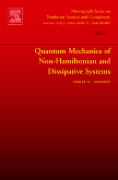
In many books about quantum mechanics for graduate students, only the unitaryevolution, Hamiltonian systems and pure states are considered. In the suggested book, the modern mathematical concepts, which are the general for Hamiltonian and non-Hamiltonian systems, are used. It allows us to formulate the quantum mechanics of a wide class of systems, such as the open, non-Hamiltonian, dissipative, and nonlinear. Hamiltonian systems in pure states and its unitary evolution are considered as special cases of quantum theory. The book is self-contained and can be used by students without a previous course in modern mathematics and physics. To read the text it is not required preliminary knowledge of graduate and advanced mathematics. All the necessary information, which is beyond undergraduate courses of the mathematics, is suggested in the book.The suggested book can be used as an introduction to modern quantum mechanics for graduate students in physics and mathematics. The part of the book can be used in the lecture courses for undergraduate students. The other part has recent fundamental results that are not considered in monographs and text books. The style of the book is oriented for mathematicians and physicists. For mathematicians, we use definitions and propositions. For physicists, the long and difficult proofs are not considered and the physical reasons to use the mathematicalstructures are discussed. It describes the structure of the modern theory. Ithas fundamental results of last 15 years. These results are not considered inthe monographs and text-books.If you would like to understand the mathematical structure of the modern quantum theory, then you must to buy the given book.The other books describe the quantum theory of first half of XX century or only small part of the modern structures. The given book can be used for theoretical physics, quantum chemistry and quantum informatics courses for graduate level students. The manuscript can be useful not only for these graduate students but also for specialists in quantum chemistry and quantum informatics, nonlinear dynamics, chaos and complexity. INDICE: Part I. Quantum Kinematics 1. Quantum Kinematics of Bounded Observables 2. Quantum Kinematics of Unbounded Observables 3. Mathematical Structures in Quantum Kinematics 4. Spaces of Quantum Observables 5. Algebras of Quantum Observables 6. Mathematical Structures on State Sets 7. Mathematical Structures in Classical Kinematics 8. Quantization in Kinematics 9. Spectral Representation of Observable Part II. Quantum Dynamics 10. Superoperators and its Properties 11. Superoperator Algebras and Spaces 12. Superoperator Functions 13. Semi-groups of Superoperators 14. Differential Equations for Quantum Observables 15. Quantum Dynamical Semi-Groups 16. Classical Non-Hamiltonian Dynamics 17.Quantization of Dynamical Structure 18. Quantum Dynamics of States 19. Dynamical Deformation of Algebras of Observables 20. Fractional Quantum Dynamics 21.Stationary States of non-Hamiltoniam Systems 22. Quantum Dynamical Methods 23. Path Integral for non-Hamiltoniam Systems 24. Non-Hamiltonian Systems as a Quantum Computers.
- ISBN: 978-0-444-53091-2
- Editorial: Elsevier Science
- Encuadernacion: Cartoné
- Páginas: 539
- Fecha Publicación: 08/05/2008
- Nº Volúmenes: 1
- Idioma: Inglés
